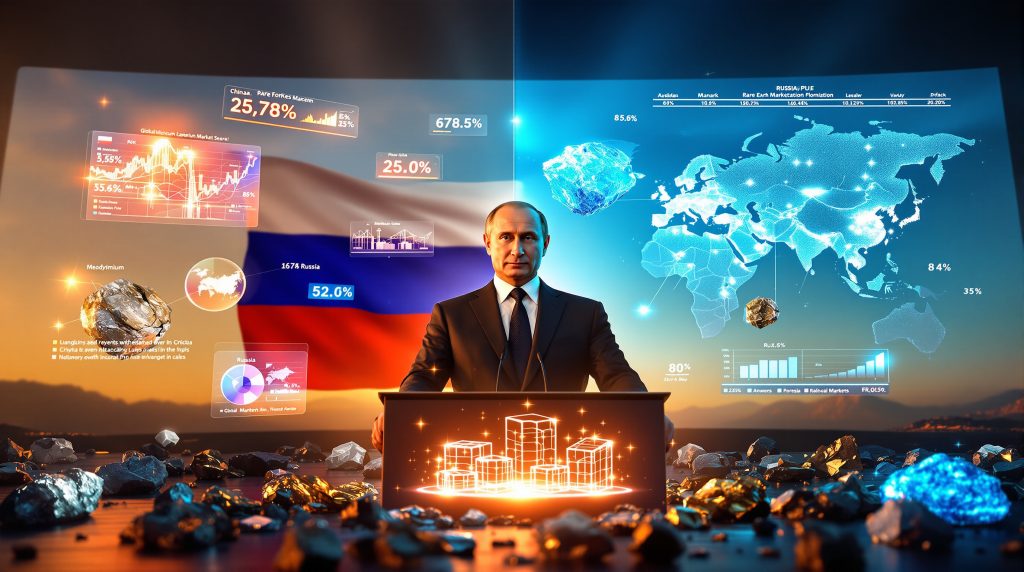Putin's December 2025 Roadmap Reshapes Global Rare Earth Strategy
Russian President Vladimir Putin has initiated a transformative shift in the global rare earth landscape by ordering his cabinet to develop a comprehensive extraction roadmap by December 1, 2025. This directive, issued on November 4, 2025, represents a calculated response to China's export restrictions and Western sanctions, positioning Russia as a potential alternative supplier in the critical minerals market that powers everything from smartphones to military systems.
The timing of this announcement coincides with escalating tensions in global supply chains, where rare earth elements have become strategic weapons in international trade disputes. As China maintains its dominant position whilst implementing export controls, and the United States seeks alternative suppliers through partnerships like the recently signed Ukraine deal, Putin orders road map for Russian rare earths extraction could fundamentally alter market dynamics.
Understanding Putin's Strategic Framework
Putin's directive emerged from action points developed during the Far Eastern Economic Forum in Vladivostok in September 2025, indicating this initiative represents part of a broader economic reorientation strategy. The roadmap carries a tight deadline, providing the Russian cabinet just 27 days to develop comprehensive extraction plans that could reshape the nation's economic future.
The strategic framework encompasses multiple interconnected objectives beyond simple mineral extraction. Furthermore, the directive explicitly calls for developing transport infrastructure at Russia's borders with both China and North Korea, suggesting an integrated approach that combines resource development with enhanced trade capabilities. This infrastructure focus indicates Russia views rare earth development as a cornerstone of its pivot toward Asian economic partnerships.
Key components of the framework include:
• Comprehensive rare earth extraction methodology development
• Multimodal transport and logistics centre establishment
• Integration with existing cross-border infrastructure
• Strategic partnership development with neighbouring countries
The compressed timeline suggests urgency driven by current market conditions, where China's export restrictions have created supply gaps that alternative producers could potentially fill. Russia's positioning as an interested partner with the United States, despite ongoing tensions over Ukraine, demonstrates the strategic importance Moscow places on this sector.
Critical Infrastructure Development Plans
Putin's directive specifically mandates the development of multimodal transport and logistics centres at Russia's borders with China and North Korea, incorporating existing railway infrastructure whilst adding new capabilities. The plan includes utilising two existing railway bridges linking Russia and China, whilst simultaneously commissioning a new bridge to North Korea by 2026.
This infrastructure development represents more than simple transportation enhancement. In addition, the multimodal approach suggests Russia envisions handling significant cargo volumes across multiple transport methods, including rail, road, and potentially river transport systems. The strategic positioning of these facilities at both Chinese and North Korean borders provides multiple export routes and reduces dependence on any single trade partnership.
The 2026 deadline for the North Korean bridge completion indicates accelerated construction timelines, likely driven by geopolitical considerations. Both Russia's far eastern neighbours have deepened economic ties with Moscow since Western sanctions were imposed over the Ukraine conflict, creating opportunities for enhanced resource trade that bypasses traditional Western-controlled supply chains.
Infrastructure specifications remain undisclosed in the initial directive, but the emphasis on logistics centres suggests comprehensive facilities capable of handling processing, storage, and distribution functions. This integrated approach could position Russia to offer complete supply chain solutions rather than simply raw material exports, complementing the global critical minerals strategy.
Rare Earth Elements: Strategic Importance Explained
Rare earth elements have evolved from specialised industrial materials to critical components of modern technological infrastructure. These 17 chemical elements, despite their name, are relatively abundant in Earth's crust but require complex processing to separate and purify for industrial applications.
The strategic importance of rare earth elements stems from their unique properties that make them irreplaceable in high-performance applications:
• Electronics Manufacturing: Essential for smartphone screens, computer hard drives, and advanced semiconductors
• Defence Systems: Critical components in precision-guided weapons, radar systems, and satellite technology
• Automotive Industry: Vital for electric vehicle motors, catalytic converters, and advanced driver assistance systems
• Renewable Energy: Indispensable for wind turbine magnets and solar panel manufacturing
The convergence of technological advancement and geopolitical tensions has transformed rare earth elements from industrial commodities into strategic assets that nations use to project economic and political influence.
The materials' strategic value extends beyond their technical applications to their role in supply chain security. Countries lacking domestic rare earth capabilities become vulnerable to export restrictions, as demonstrated by China's recent actions in response to US trade policies. This vulnerability explains why nations are actively seeking supply chain diversification through partnerships with alternative suppliers.
Russia's entry into this market addresses not only its own economic interests but also provides potential customers with reduced supply chain risk through geographic and political diversification. This development aligns with broader energy transition security concerns globally.
Global Market Dynamics and Supply Vulnerabilities
China currently dominates rare earth production and has leveraged this position strategically in international trade disputes. In 2025, China implemented export restrictions as a response to US tariffs, demonstrating how rare earth supplies can become tools of economic statecraft.
The global market structure reveals concerning concentration patterns:
| Supply Concentration | Current Status | Risk Level |
|---|---|---|
| Chinese Production Dominance | Primary global supplier | High vulnerability |
| Processing Capabilities | Concentrated in few facilities | Critical bottleneck |
| Alternative Suppliers | Limited scale operations | Insufficient backup capacity |
| Strategic Stockpiles | Variable by country | Inadequate for extended disruption |
This concentration creates systemic vulnerabilities that extend far beyond simple supply shortages. Manufacturing disruptions can cascade through entire technology sectors, affecting everything from consumer electronics to defence systems. Consequently, the strategic implications become particularly acute when supply restrictions are implemented during geopolitical tensions.
Recent developments illustrate these vulnerabilities in action. The US mineral production order announced in April 2025 seeks to develop alternative supply sources, whilst Russia expresses interest in partnering with the United States on rare earth projects despite ongoing conflicts. These seemingly contradictory diplomatic overtures underscore how critical mineral security transcends traditional political alignments.
Supply chain resilience requires multiple independent suppliers with sufficient capacity to meet global demand. Russia's potential entry as a significant producer could provide the market diversification necessary to reduce current vulnerabilities.
Russia's Competitive Position and Advantages
Russia possesses substantial untapped rare earth reserves, particularly concentrated in the Far Eastern regions referenced in Putin's directive. Whilst comprehensive geological surveys remain proprietary, independent assessments suggest Russia controls significant deposits that could support large-scale commercial extraction.
The country's competitive advantages extend beyond raw material availability:
• Metallurgical Expertise: Decades of experience in complex mineral processing and refining
• Energy Resources: Abundant low-cost energy for processing-intensive operations
• Geographic Position: Strategic location between major Asian markets and European consumers
• Infrastructure Foundation: Existing rail and port facilities that can be adapted for rare earth logistics
Russia's existing metallurgical industry provides a foundation that many potential competitors lack. However, the technical expertise required for rare earth separation and purification builds upon skills developed in other mineral processing sectors, potentially reducing the learning curve for commercial operations.
The energy-intensive nature of rare earth processing gives Russia a significant cost advantage. Countries with high energy costs struggle to compete economically in this sector, whereas Russia's abundant energy resources enable competitive pricing even with comprehensive environmental controls.
Geographic positioning offers unique strategic value. For instance, Russia can serve both European and Asian markets through established trade routes, potentially capturing market share from multiple regions simultaneously. This positioning complements global raw material facilities development efforts.
Geopolitical Implications and Market Responses
Russia's rare earth initiative occurs within a complex geopolitical landscape where traditional alliances intersect with resource security imperatives. The statement that Russia remains interested in partnering with the United States on rare earth projects, despite ongoing tensions over Ukraine, illustrates how critical mineral access can create unlikely diplomatic opportunities.
Western sanctions have paradoxically created incentives for Russia to develop domestic capabilities whilst strengthening partnerships with Asian neighbours. Both China and North Korea have deepened economic ties with Moscow since sanctions were implemented, providing potential markets and partnerships that could support Russia's rare earth ambitions.
The broader implications include:
• Supply Chain Reconfiguration: Major technology companies may need to evaluate new supplier relationships
• Strategic Stockpiling: Countries may accelerate efforts to build domestic reserves
• Technology Transfer: Equipment and expertise sourcing becomes increasingly complex under sanctions regimes
• Price Volatility: Market uncertainty during supply source transitions typically increases price fluctuations
China's response to increased competition will likely determine market dynamics over the coming decade. Historical patterns suggest China may either increase its own export restrictions to maintain market share or accelerate domestic consumption to reduce available supplies for export markets.
European Union countries face particularly complex decisions, as they must balance supply security concerns against political considerations regarding Russian partnerships. Putin orders roadmap for Russian rare earths extraction creates technical reality that rare earth alternatives remain limited may force pragmatic approaches that prioritise supply chain resilience over political preferences.
Infrastructure Investment and Technical Challenges
Developing competitive rare earth capabilities requires substantial infrastructure investments beyond simple mining operations. The processing and refining stages demand sophisticated facilities with stringent environmental controls and specialised technical expertise.
Russia must address several technical challenges to achieve commercial viability:
Processing Technology Requirements:
• Advanced separation equipment for individual rare earth elements
• Environmental containment systems for radioactive materials processing
• Quality control laboratories for product specification verification
• Skilled workforce development in specialised extraction techniques
Infrastructure Development Needs:
• Processing facility construction in strategic locations
• Transportation systems capable of handling hazardous materials
• Power grid enhancements to support energy-intensive operations
• Waste management facilities for processing byproducts
The multimodal transport and logistics centres specified in Putin's directive address some of these challenges by creating integrated facilities that can handle multiple stages of the supply chain. This approach potentially reduces transportation costs and improves operational efficiency compared to geographically dispersed operations.
Sanctions complicate technology acquisition, particularly for Western-manufactured processing equipment. Consequently, Russia may need to develop domestic alternatives or source technology from Chinese suppliers, potentially affecting operational efficiency and timeline achievement. This challenge reflects broader trends in mining industry evolution worldwide.
Market Psychology and Investment Implications
Russia's entry into the rare earth market introduces new variables into investment calculations across multiple sectors. Technology companies dependent on stable rare earth supplies must evaluate whether Russian sources provide genuine supply security or introduce additional geopolitical risks.
Investment considerations include:
• Supply Diversification Benefits: Reduced dependence on Chinese sources
• Geopolitical Risk Assessment: Sanctions and political stability concerns
• Price Impact Analysis: Competition effects on long-term pricing
• Strategic Partnership Evaluation: Direct investment versus purchase agreement strategies
The psychological impact on markets may exceed immediate physical supply changes. For instance, announcements of alternative supply sources often reduce price premiums associated with supply security concerns, even before actual production begins.
Private equity and sovereign wealth funds face complex decisions regarding Russian rare earth investments. Whilst potential returns could be substantial given market demand projections, sanctions risks and political considerations create uncertainty that traditional risk assessment models struggle to quantify.
Technology Sector Supply Chain Implications
Major technology manufacturers currently face difficult decisions regarding supply chain diversification strategies. Russian rare earth supplies could provide genuine alternatives to Chinese sources, but incorporating Russian suppliers requires careful evaluation of long-term sustainability and political risk factors.
Supply Chain Restructuring Considerations:
- Qualification Processes: Technical evaluation of Russian rare earth quality and consistency
- Contract Structures: Long-term agreements versus spot market purchases
- Risk Management: Hedging strategies for geopolitical disruption scenarios
- Regulatory Compliance: Sanctions navigation and legal requirement fulfilment
The automotive sector, particularly electric vehicle manufacturers, may benefit significantly from rare earth supply diversification. Battery technology and electric motors require consistent access to specific rare earth elements, making supply security a critical competitive factor.
Defence contractors face unique challenges, as government regulations may restrict or prohibit Russian rare earth usage regardless of commercial viability. This sector may require separate supply chain strategies that prioritise political acceptability over economic efficiency.
Environmental and Regulatory Considerations
Rare earth extraction and processing create significant environmental challenges that Russia must address to achieve international market acceptance. Modern consumers and corporations increasingly demand sustainable sourcing practices, making environmental compliance essential for market access.
Key environmental concerns include:
• Radioactive Material Management: Many rare earth deposits contain thorium and uranium
• Water Resource Protection: Processing requires substantial water usage and contamination prevention
• Air Quality Control: Dust and chemical emission management during extraction and processing
• Waste Stream Treatment: Proper disposal of processing byproducts and contaminated materials
International customers, particularly European companies, may require environmental certification that meets or exceeds domestic standards. Furthermore, this requirement could necessitate additional investment in environmental controls that increase operational costs but enable premium market access.
Russian regulatory frameworks must evolve to support rare earth development whilst maintaining environmental protections. Streamlined permitting processes balanced with rigorous environmental oversight will be crucial for achieving the ambitious timelines outlined in Putin's directive.
Long-term Market Outlook and Strategic Implications
Russia's rare earth initiative represents more than simple market entry; it signals a fundamental shift toward resource-based geopolitical influence that could reshape international relations. Success in this sector could provide Russia with economic leverage that transcends traditional energy exports.
The timeline for meaningful market impact extends beyond the December 2025 roadmap completion. Commercial production typically requires 3-5 years following initial development approval, suggesting Russian supplies may not significantly impact global markets until 2028-2030.
Projected Development Phases:
| Phase | Timeline | Key Milestones | Market Impact |
|---|---|---|---|
| Planning & Approval | 2025-2026 | Roadmap completion, regulatory approval | Minimal direct impact |
| Infrastructure Development | 2026-2028 | Facility construction, equipment installation | Price volatility reduction |
| Commercial Production | 2029-2032 | Full-scale operations, export commencement | Significant supply diversification |
| Market Maturation | 2032+ | Established supplier relationships | Structural market changes |
The success of Russia's rare earth strategy will largely depend on its ability to navigate sanctions restrictions, develop technical expertise, and establish reliable customer relationships. Each of these factors presents significant challenges that could delay or limit the initiative's ultimate impact.
However, the strategic importance of rare earth supply diversification provides strong incentives for potential customers to work with Russian suppliers despite political complications. Market forces may ultimately overcome political preferences when supply security becomes critical for economic competitiveness.
Disclaimer: This analysis contains forward-looking projections and geopolitical assessments that are subject to significant uncertainty. Rare earth market developments depend on numerous factors including regulatory changes, technological advances, and international political developments that cannot be predicted with certainty. Investors should conduct independent research and consider professional advice before making investment decisions related to rare earth markets or Russian industrial sectors.
Ready to Invest in the Next Critical Minerals Breakthrough?
Discovery Alert's proprietary Discovery IQ model delivers real-time alerts on significant ASX mineral discoveries, instantly empowering subscribers to identify actionable opportunities ahead of the broader market. Understand why major mineral discoveries can lead to substantial returns by exploring historic examples, then begin your 30-day free trial today to position yourself ahead of critical developments like Russia's rare earth strategy shift.




